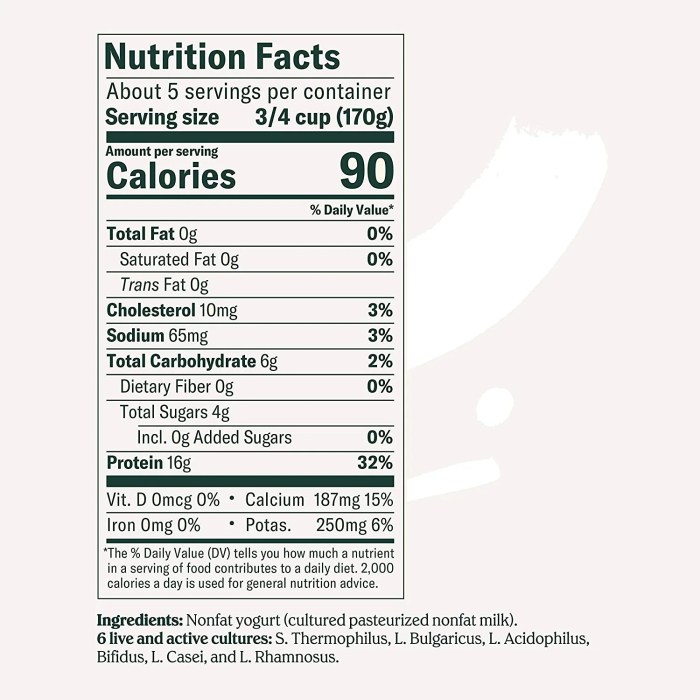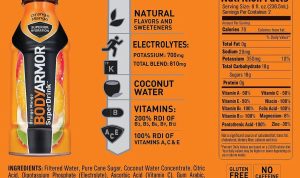Nutritional Composition of Chobani Greek Yogurt

Chobani greek yogurt nutrition facts – Chobani Greek yogurt is a popular dairy product known for its high protein content and creamy texture. Understanding its nutritional profile is key to making informed dietary choices. This section details the macronutrient composition, vitamin and mineral content, and probiotic profile of various Chobani flavors. Variations exist depending on the specific flavor and whether it’s plain or fruit-flavored.
Macronutrient Breakdown in Chobani Greek Yogurt, Chobani greek yogurt nutrition facts
The macronutrient content of Chobani Greek yogurt varies slightly depending on the flavor and serving size. Generally, a typical serving (5.3 oz or 150g) is a good source of protein and relatively low in fat, particularly in plain varieties. Fruit-flavored options will naturally contain more carbohydrates due to the added fruit. Specific values should always be checked on the individual product packaging as formulations can change.
However, we can offer a general overview. Plain Chobani Greek yogurt tends to be higher in protein and lower in carbohydrates and fat compared to its fruit-flavored counterparts. Fruit additions increase the sugar and carbohydrate content. For example, a plain non-fat Chobani might have approximately 15-17 grams of protein, 0-1 gram of fat, and 7-9 grams of carbohydrates per serving.
A fruit-flavored variety might show slightly lower protein, a bit more fat (from the fruit itself), and significantly more carbohydrates (15-20 grams or more).
Vitamins and Minerals in Chobani Greek Yogurt
Chobani Greek yogurt provides several essential vitamins and minerals. Plain varieties are generally a good source of calcium and protein, contributing to bone health and muscle building. The addition of fruit in flavored yogurts can increase the vitamin C content, though this also increases the sugar content. The exact amounts of vitamins and minerals vary depending on the specific flavor and any added ingredients.
For instance, some fruit-flavored options might include added vitamin D. Checking the nutrition label on the specific product is crucial for detailed information. It is important to note that while Chobani Greek Yogurt offers some vitamins and minerals, it should not be considered a sole source for these nutrients. A balanced diet is essential for overall health.
Probiotic Content and Health Benefits
Chobani Greek yogurt contains live and active cultures, also known as probiotics. These beneficial bacteria contribute to gut health. While the exact strains and quantities may vary slightly depending on the flavor and production batch, Chobani generally uses strains known for their positive impact on digestion and immune function. The health benefits of probiotics include improved digestion, enhanced immune response, and potential reduction of inflammation.
However, individual responses to probiotics can vary.
Chobani Greek yogurt boasts a high protein content, making it a popular choice for breakfast or a healthy snack. For those interested in incorporating more vegetables into their diet, a helpful resource for understanding the nutritional benefits is available at cherry tomato nutrition facts , which provides valuable insights into the vitamins and antioxidants found in these small fruits.
Returning to Chobani yogurt, its nutritional profile complements a balanced diet, offering calcium and probiotics alongside its protein.
| Flavor | Protein (grams) | Fat (grams) | Carbohydrates (grams) |
|---|---|---|---|
| Plain Non-Fat | 17 | 0 | 7 |
| Blueberry | 14 | 0.5 | 18 |
| Strawberry | 15 | 0.5 | 19 |
*(Note: These values are approximate and may vary slightly depending on the specific product and serving size. Always refer to the nutrition label on the packaging for the most accurate information.)*
Comparison with Other Yogurts: Chobani Greek Yogurt Nutrition Facts
Chobani Greek yogurt has gained significant popularity, but its nutritional profile stands in comparison to other yogurt options on the market. Understanding these differences is crucial for consumers seeking specific nutritional benefits. This section will compare Chobani Greek yogurt to other popular Greek yogurt brands and traditional yogurts, highlighting key nutritional variations and their implications for consumers.
The following points compare Chobani Greek yogurt with other popular yogurt brands, both Greek and traditional, considering various nutritional aspects relevant to different dietary needs.
Nutritional Profile Comparison Across Brands
- Protein Content: Greek yogurts generally boast higher protein content than traditional yogurts. Chobani often competes favorably with other leading Greek yogurt brands like Fage and Oikos in terms of protein per serving, usually ranging between 15-20 grams. Traditional yogurts, however, typically contain significantly less protein, often around 5-10 grams per serving.
- Fat Content: Variations in fat content exist across brands and product lines (e.g., nonfat, low-fat, whole milk). Chobani offers options across this spectrum, allowing consumers to choose based on their preferences. Some brands may emphasize low-fat options, while others highlight the benefits of full-fat varieties. This is a key differentiator for consumers focusing on fat intake.
- Sugar Content: Added sugars are a significant concern. While plain varieties of all yogurts generally have lower sugar content, flavored options can vary greatly. Some brands may use more natural sweeteners like fruit purees, while others rely on added sugars or artificial sweeteners. Chobani’s sugar content in flavored varieties should be compared to competitors on a per-serving basis to determine differences.
- Calcium and Vitamin Content: Most yogurts are good sources of calcium and certain vitamins. However, fortification levels can vary between brands. Comparing the nutritional labels of Chobani and other brands will reveal differences in the amounts of calcium, vitamin D, and other vitamins present.
Impact of Added Sugars and Sweeteners
The addition of sugars significantly impacts the overall nutritional value of yogurt. While some added sugar contributes to flavor and palatability, excessive amounts can increase calorie intake and negatively affect blood sugar levels. Consumers with diabetes or those monitoring their sugar intake should carefully compare the added sugar content across different yogurt brands and choose plain varieties or those sweetened with natural alternatives whenever possible.
For example, comparing a flavored Chobani to a similarly flavored Fage Total 0% milkfat yogurt might reveal differences in added sugar that could be significant for individuals watching their sugar intake.
Dietary Implications for Specific Needs
The nutritional differences between yogurt types have important implications for consumers with specific dietary needs. For instance, individuals on high-protein diets might prioritize Greek yogurts like Chobani for their protein content. Conversely, those focusing on low-fat intake might choose nonfat or low-fat options from various brands. People with lactose intolerance might consider lactose-free options available from various brands, including Chobani.
Labeling and Ingredient Analysis

Understanding the information presented on a Chobani Greek Yogurt label is crucial for making informed dietary choices. The label provides a comprehensive overview of the product’s nutritional content and ingredients, allowing consumers to assess its suitability for their individual needs and preferences. This analysis will examine a typical Chobani label and delve into the ingredient list of a specific flavor to illustrate these points.
Typical Chobani Greek Yogurt Label Information
A typical Chobani Greek yogurt label includes several key components. Firstly, the Nutrition Facts panel provides a detailed breakdown of the serving size, calories, total fat, saturated fat, trans fat, cholesterol, sodium, total carbohydrate, dietary fiber, total sugars, added sugars, protein, and vitamin D and calcium content. This information is vital for individuals monitoring their daily intake of various nutrients.
Secondly, the ingredient list provides a comprehensive breakdown of all the ingredients used, listed in descending order by weight. This allows consumers to identify potential allergens or additives. Finally, the label often includes statements regarding the product’s certifications (e.g., Non-GMO Project Verified), production facility information, and any relevant warnings or cautions. The presence of a best-by date is also standard.
Ingredient List Analysis: Plain Nonfat Greek Yogurt
Let’s analyze the ingredient list of a common Chobani product, Plain Nonfat Greek Yogurt. A typical ingredient list would read something like: “Milk, Active Yogurt Cultures (S. thermophilus, L. bulgaricus).” This simplicity highlights the core nature of the product: milk is the primary ingredient, providing the protein and dairy components. The “Active Yogurt Cultures” represent the live and active bacteria responsible for the fermentation process, giving Greek yogurt its characteristic tangy flavor and texture.
The absence of other ingredients indicates the plain nature of this particular variety. The absence of added sugars, artificial flavors, or colors is significant for consumers seeking a less processed option.
Potential Allergens and Additives in Chobani Greek Yogurt
While plain Chobani Greek yogurt typically contains only milk and active yogurt cultures, variations like flavored yogurts may include additional ingredients that could be potential allergens or additives. Common allergens found in some Chobani flavors might include milk (a primary ingredient), nuts (in nut-flavored varieties), and soy (in some flavored varieties). Additives, such as artificial sweeteners, colors, or flavors, might also be present in certain flavors.
It’s crucial for consumers with allergies or sensitivities to carefully examine the ingredient list of the specific Chobani flavor they intend to purchase to identify potential allergens. The implications for consumers with allergies can be severe, ranging from mild discomfort to life-threatening anaphylaxis. Therefore, careful reading of the label is essential.
General Inquiries
Is Chobani Greek yogurt suitable for people with lactose intolerance?
Some individuals with lactose intolerance may tolerate Chobani Greek yogurt better than other dairy products due to the fermentation process, which reduces lactose content. However, it’s not guaranteed to be tolerated by everyone. Individuals with severe lactose intolerance should proceed with caution and monitor their reaction.
How does the sugar content vary across different Chobani flavors?
Sugar content significantly varies depending on the flavor. Plain, non-sweetened varieties have the lowest sugar, while fruit-flavored options generally contain added sugars. Always check the nutrition label for specific sugar content per serving.
Can Chobani Greek yogurt help with weight management?
Chobani Greek yogurt’s high protein content can contribute to feelings of fullness and satiety, potentially aiding in weight management. However, it’s essential to consider the overall calorie and sugar intake when incorporating it into a weight-management plan.
Are there any potential interactions with medications when consuming Chobani Greek yogurt?
While generally safe, there is no known significant interaction between Chobani Greek yogurt and common medications. However, individuals with specific health conditions or those taking medications should consult with a healthcare professional or registered dietitian to discuss any potential concerns.





